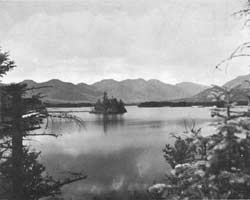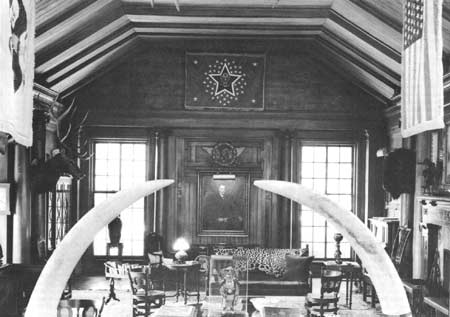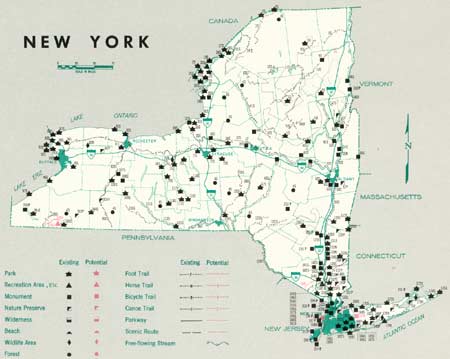.gif)
Parks for America
MENU
|
Parks for America
|

|
NEW YORK

|
| Elk Lake, N.Y., exemplifies the unspoiled beauty of the Adirondack Forest Preserve, a million-acre reservation, much of which is protected as wilderness by New York's constitution. Such wilderness recreation resources are becoming very rare in the East. |
NEW YORK has varied and abundant natural resources sufficient to fill a portion of the recreation needs of the eastern seaboard "megalopolis."
In the decade 1950—60, New York experienced a population growth of over 950,000. Urban population,in 1960, was in excess of 85 percent of the total. Density ranges from about 2 per square mile in Hamilton County in the Adirondacks to 77,195 in New York County. Six counties in the New York metropolitan region contain almost 58 percent of the total State population on some 2 percent of the land area of the State. Projections indicate that State population will increase from 16,782,304 in 1960 to 19,859,000 by 1976.
The tourist and vacation industry in New York is one of the three top-ranking sources of income in the State. Tourist expenditures in 1960 are estimated at $2.6 million. This figure includes expenditures by tourists for urban types of recreation. Expenditure figures for nonurban recreation activities are not available but are believed to be substantial.
The State has long been aware of the importance of providing a fast, safe highway system. This has resulted in a system of high-caliber roads. The Interstate Highway System, as proposed, will provide fast access from the highly populated areas to the recreation resources of the State.
Mountains, forests, lakes, and rivers abound through out the State. To the south and east are the Atlantic Ocean, Long Island Sound, the Hudson River, Lake George and Lake Champlain; to the north and west, the St. Lawrence River with the Thousand Islands region, Lake Ontario, the Niagara River, Niagara Falls, and Lake Erie. In between are the Finger Lakes region, the Catskill Mountains, the Mohawk River Valley, and the Adirondack Mountains.
Winter sports, particularly skiing, are almost as important as summertime activities. Hunting and fishing offer important recreation opportunities for residents and out-of-State visitors.
EXISTING PUBLIC AREAS
NATIONAL: The National Park Service administers nine historic areas totaling 2,820 acres. Visitation in 1960 was 1,310,000. Four national wildlife refuges of 10,118 acres are administered by the Bureau of Sport Fisheries and Wildlife.
STATE: The Division of State Parks administers 91 State parks totaling 185,231 acres and 26 historic sites with a total of 829 acres. The combined 1960 visitation was 31,073,757. The Adirondack and Catskill Forest Preserves, plus four other areas, with a combined total acreage of 2,521,289, are administered by the Division of Lands and Forests. These 6 areas include 42 developed recreation sites. Visitation in 1960 was 2,965,942. The division also administers 565,695 acres in reforestation projects. The Division of Fish and Game administers 34 game management areas totaling 103,762 acres. There are some 90 waysides under the Department of Highways.
LOCAL: County park authorities administer over 23,783 acres in some 31 nonurban parks, and 1 historic monument is in local public ownership.
QUASI-PUBLIC AND PRIVATE: Fifteen natural areas, totaling 4,392 acres, and 16 historic monuments are preserved by quasi-public and private interests.
PRIVATE ENTERPRISE: Private recreation facilities are important to vacationers in some parts of the State, particularly in the north. Cabins, lodges, boat rental, guide services, group camps, etc., are usually privately owned and operated.
PARK AND RELATED NEEDS
The need for recreation in New York State is centered upon the New York City metropolitan region, with smaller focal points at other population centers. It is a familiar problem in that much of the State's recreation resources is not close or immediately available to the urban areas that need them most. The suitable open lands remaining near these urban areas must be acquired quickly by appropriate public agencies before they disappear under pressure of private development and increasing population.
These factors will make it unnecessary to jeopardize New York's wealth of protected wilderness, which can provide other types of outdoor recreation to an extent now seldom found in the East. Thus, estimates of the State's mass recreation land requirements need only take into limited account the present acreage in the Adirondack and Catskill preserves, vast though it be. The more accessible portions could continue, as they do now with the extensive campsite facilities, to play a part in more diversified recreation as population pressures increase and as studies and legislation now under consideration are further developed. However, the State will undoubtedly continue, under constitutional limits, to exercise caution and judgment in the use of New York's wildlands for intensive recreation.
Existing State park areas now provide some 191,900 acres and local nonurban parks some 23,800 acres for the State's nearly 17 million people.
The principal needs are (1) additional lands for State parks and mass recreation within day-use distance of "areas of deficiency"; (2) areas for camping through out the State; (3) mixed-use areas for the long-term future; and (4) miscellaneous needs such as boat launching sites and wetland preservation.
Also needed urgently is more land for local parks near cities, especially in the big suburban towns and counties where population growth concentrates at the expense of remaining land.
The first stage of this need is now well underway with the $75 million parkland bond issue. Under a $20 million allocation for State parks, 15 new parks and 35 substantial additions to existing parks aggregating about 30,000 acres are being acquired. A similar allocation of $15 million is providing valuable additions to State preserves, reforestation areas, game areas, boat-launching sites, wetlands, fishing streams, and multiple-purpose areas. The remaining $40 million has been allocated for grants to municipalities to acquire additional local parkland, with the State paying 75 percent of the cost of the land.
All of these programs are moving rapidly—some of them past the halfway point—and a supplemental bond issue of $25 million was approved in the 1962 general election.
Planning and development will continue as needed, but the State has taken and is progressing rapidly with the first and most essential step in providing for recreation needs, the setting aside of sufficient land.

|
| President Theodore Roosevelt's personality and stature as outdoorsman, conservationist, statesman is felt in the living room at his Sagamore Hill home on Long Island, recently established as a national historic site. |
RECOMMENDATIONS
Existing recreation resources, as well as 12,247 acres of potential areas of State significance, are shown on the accompanying tabulation and map. No potential local nonurban parks have been identified. The following recommendations are offered:
NATIONAL: Establishment of Hamilton Grange National Memorial as authorized by Congress. Consideration of an Appalachian Parkway as an extension of the Blue Ridge Parkway and Skyline Drive. A study to determine feasibility of an Ohio River-Allegheny River Parkway. A Fire Island National Seashore, including Fire Island and other seashore areas on Long Island, has been recommended since preparation of the map and tabulation that follow.
STATE: Development of the Allegheny River Reservoir as a regional recreation area. Preservation of the Ausable River as a free-flowing stream.
Supporting recommendations include—
1. Expansion of the State park system to insure preservation of important remaining areas. Acquisition by appropriate agencies of land for nature preserves, wildlife refuges, and historical preservation. Studies to locate such areas on Long Island and in southeastern New York should be undertaken as soon as possible.
2. Lakes and seashores, rivers, and streams should be freed of pollution and, where feasible, protected either by acquisition, scenic easements, or zoning. Systems of marina developments in conjunction with recreation waterways, Great Lakes shorelines, and Long Island Sound should be considered.
3. Free-flowing streams such as the Ausable River should be preserved in their natural condition and canoe routes developed on suitable streams. Highways through scenic areas should be developed as recreation roads, and scenery should be protected along highways, particularly those leading into vacation regions.
4. Reforestation projects should be expanded and, where feasible, developed for intensive day use and weekend recreation.
(Table omitted from online edition)

|
| (click on image for an enlargement in a new window) |
NEXT >>>
|
|
Last Modified: Mon, Sep 6 2004 10:00:00 pm PDT
parks_america/new_york.htm
 Top
Top